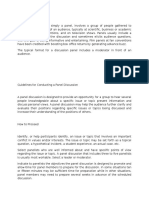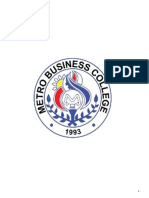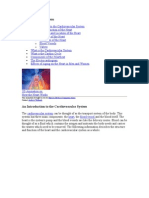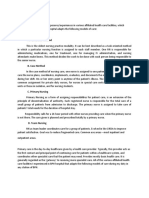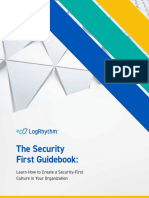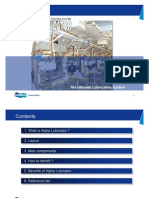0 ratings0% found this document useful (0 votes)
1K viewsLec 10 Uses of Email and Internet in Business
Lec 10 Uses of Email and Internet in Business
Uploaded by
Rajja RashadThe document discusses the evolution and use of email in business communications. It notes that email has become an effective and low-cost method of communication that allows instant transmission of messages to single or multiple recipients. The document provides tips for writing effective business emails, such as using clear subjects, appropriate tone, and proofreading messages before sending. It also discusses how email has changed internal company communications by allowing direct messaging between all staff.
Copyright:
© All Rights Reserved
Available Formats
Download as PPTX, PDF, TXT or read online from Scribd
Lec 10 Uses of Email and Internet in Business
Lec 10 Uses of Email and Internet in Business
Uploaded by
Rajja Rashad0 ratings0% found this document useful (0 votes)
1K views13 pagesThe document discusses the evolution and use of email in business communications. It notes that email has become an effective and low-cost method of communication that allows instant transmission of messages to single or multiple recipients. The document provides tips for writing effective business emails, such as using clear subjects, appropriate tone, and proofreading messages before sending. It also discusses how email has changed internal company communications by allowing direct messaging between all staff.
Original Title
Lec 10 Uses of email and internet in business
Copyright
© © All Rights Reserved
Available Formats
PPTX, PDF, TXT or read online from Scribd
Share this document
Did you find this document useful?
Is this content inappropriate?
The document discusses the evolution and use of email in business communications. It notes that email has become an effective and low-cost method of communication that allows instant transmission of messages to single or multiple recipients. The document provides tips for writing effective business emails, such as using clear subjects, appropriate tone, and proofreading messages before sending. It also discusses how email has changed internal company communications by allowing direct messaging between all staff.
Copyright:
© All Rights Reserved
Available Formats
Download as PPTX, PDF, TXT or read online from Scribd
Download as pptx, pdf, or txt
0 ratings0% found this document useful (0 votes)
1K views13 pagesLec 10 Uses of Email and Internet in Business
Lec 10 Uses of Email and Internet in Business
Uploaded by
Rajja RashadThe document discusses the evolution and use of email in business communications. It notes that email has become an effective and low-cost method of communication that allows instant transmission of messages to single or multiple recipients. The document provides tips for writing effective business emails, such as using clear subjects, appropriate tone, and proofreading messages before sending. It also discusses how email has changed internal company communications by allowing direct messaging between all staff.
Copyright:
© All Rights Reserved
Available Formats
Download as PPTX, PDF, TXT or read online from Scribd
Download as pptx, pdf, or txt
You are on page 1of 13
Lecture 10
• Most of the activities in today’s offices are
electronic, using computer-based technology.
Electronic mail, or e-mail as it is commonly
known, has evolved as an effective, low-cost
and instant method of communication in
business all over the world.
• With e-mail, messages are keyed into a
computer workstation and then transmitted
to the recipient. A single message may be sent
simultaneously to many recipients.
• E-mail saves a lot of time and effort in producing
formal, printed memos, faxes and letters. Many
e-mail messages are short and may be deleted
after a few days or weeks. With longer or more
important messages, they may be retained on the
electronic file or printed out as a hard copy.
– high speed send/receive cycle
– direct input and retrieval from keyboard
– virtually instant despatch/retrieval
– simultaneous circulation to pre-selected groups
– other files can be attached to e-mails.
• Do not use vague subject line
– You must compose a SMART subject line that is:
• Specific
• Meaningful
• Appropriate
• Relevant
• Thoughtful
• Carefully use words while drafting an e-mail
• Always consider tone carefully
• Doesn’t use abbreviations in business e-mails
• Send CCs (Courtesy copy) only when necessary
• Checks all messages carefully before sending
• Always include a greeting and sign-off
• Never send sloppy e-mails
• Never uses old-fashioned clichés
• Don’t just dive into your message
– Try to ease the reader into your message by giving some
basic background information. Be warm and friendly in
your opening where possible.
• Show some feelings
– Add texture to your message by using emotive and sensory
words. Showing some empathy in your message will help
you to form a better bond with your readers.
• Keep your message positive and focused
– Keep a positive attitude towards your reader and maintain
a focus on their needs. Try to be diplomatic, and never be
afraid to apologise if something has gone wrong.
• Tailor the tone of your message
– The speed of e-mail can lead to inappropriate
informality. Be careful to tailor the tone of your
message accordingly. Distinguish personal from
business e-mails, and avoid using abbreviations,
exclamation marks and slang when writing to clients.
• Be precise and clear
– All readers deserve a clear and professional message.
Pay attention to what is being asked and respond
clearly. If you are not precise this will make more work
because a further e-mail will be necessary.
• Traditionally internal communications in business were
hierarchical, with messages being passed up and down the
chain, often with secretaries acting as a filter between
managers and staff.
• Flatter company structures have changed the whole
spectrum of internal communications. A network has now
replaced the hierarchical model. With e-mail, every member
of staff is able to communicate directly with everyone else –
up, down and across the organisation This flatter
organisation structure, and the new power of employees to
communicate company-wide, means that information can
be distributed more efficiently around the organisation.
• However, because of the relative ease of sending e-mail,
messages may sometimes be sent without due thought and
consideration.
• E-mail has undoubtedly helped us to establish
and maintain business relationships with
branches, clients, suppliers, etc. Relationships
with customers and co-workers can be improved
and productivity can be enhanced considerably
through effective use of e-mail.
• It used to be said that the business letter was an
ambassador for your company, so it should
therefore give a very good impression. The same
can now be said of e-mail messages. You should
take care with all your e-mail messages so that
they give a good impression of you and your
company.
• Internet comprises millions of pages of words,
pictures, sounds and graphics stored on
computers connected to the Internet.
– A collection of web pages created by a single
organisation is called a website.
– Every website has its own address, called a
URL(Uniform Resource Locator):
• Hundreds of companies are going online every week.
Internet is an important development that had such an
impact on the way business is conducted.
• Businesses are increasingly looking towards the
Internet as a means of advertising, selling and
distributing their services. You can book hotel rooms,
flights, hire a car all without leaving your desk and
even without picking up a phone. People are regularly
shopping online for certain goods, especially books and
CDs, even groceries. You can often track the progress of
parcels or other deliveries online. There seems no limit
to the capabilities of the Internet. It is a host to a
wealth of information and services – so whatever you
need to find out or order, it is probably on the Internet.
• Intranets are internal • An extranet is created by a
Internets. company to offer
customers, suppliers, and
• An intranet is like a company’s vendors specific data
own internal version of the without allowing them
Internet. A company’s intranet access to other proprietary
can contain a wealth of or sensitive company data.
information about the • Information and data can
company, with each be isolated through
department having its own extranet so that a business
site and information being
partner, customer, or
vendor may only access the
made available to everyone information important to
within the company – but not their operations, and
other people outside the prohibits access to other
company. sensitive company data.
You might also like
- 9100 User ManualDocument48 pages9100 User Manualหน่อง นพดล83% (36)
- Naf College of Nursing Sciences Students Handbook 1659686167Document47 pagesNaf College of Nursing Sciences Students Handbook 1659686167dj5435932100% (1)
- Pcos Pamphlet Dani UpdatedDocument6 pagesPcos Pamphlet Dani Updatedapi-265675998No ratings yet
- Ethics 06-Development of Moral CharacterDocument16 pagesEthics 06-Development of Moral CharacterApril ManaloNo ratings yet
- Panel DiscussionDocument2 pagesPanel DiscussionReden Basag IlokNo ratings yet
- Parts of The TongueDocument3 pagesParts of The TongueDemi LlaireNo ratings yet
- Principles of LearningDocument3 pagesPrinciples of LearningHussin, FarahNo ratings yet
- Panel DiscussionDocument30 pagesPanel DiscussionShibin JacobNo ratings yet
- Importance of Research in NursingDocument5 pagesImportance of Research in NursingAleena ShibuNo ratings yet
- Maternal Role Attainment Theory IDocument7 pagesMaternal Role Attainment Theory IswethashakiNo ratings yet
- School Health ServicesDocument2 pagesSchool Health ServicesCrystal Ann Monsale TadiamonNo ratings yet
- Problem Solution Unwanted Pregnancy - Student ExampleDocument4 pagesProblem Solution Unwanted Pregnancy - Student ExampleFlávia FermonNo ratings yet
- Fetal DevelopmentDocument43 pagesFetal DevelopmentRob N Michelle50% (2)
- The Seven C's of CommunicationDocument6 pagesThe Seven C's of CommunicationMarie Sachie Mitsui Padillo TurianoNo ratings yet
- Fire Safety Disaster PlanningDocument20 pagesFire Safety Disaster PlanningprabhatNo ratings yet
- Course Outline in Lit 1Document5 pagesCourse Outline in Lit 1angeloNo ratings yet
- NCERT Class 9 English Main Course Book Unit 1 PeopleDocument23 pagesNCERT Class 9 English Main Course Book Unit 1 PeopleSai Swarup SahuNo ratings yet
- Parts of A Research ReportDocument8 pagesParts of A Research ReportjonnNo ratings yet
- Module On Purposive CommunicationDocument31 pagesModule On Purposive CommunicationMariel C. SegadorNo ratings yet
- Cardiovascular SystemDocument6 pagesCardiovascular Systemtasneem8No ratings yet
- Nurse's Bill of RightsDocument10 pagesNurse's Bill of RightsNapoleon Tuballes AbonalesNo ratings yet
- TFN Advance ReadingDocument6 pagesTFN Advance ReadingLea FajardoNo ratings yet
- Nursing Procedures Hair Shampoo in Bed PurposeDocument3 pagesNursing Procedures Hair Shampoo in Bed PurposeJill Cabasag BustaliñoNo ratings yet
- 2 Hand HygieneDocument44 pages2 Hand Hygieneregisterpy0% (1)
- Handwashing-ChecklistDocument1 pageHandwashing-Checklistmorseekodee101No ratings yet
- Soft Skills EssayDocument3 pagesSoft Skills Essayapi-529186757No ratings yet
- 24.postpartum Period-Physiological Changes in The MotherDocument16 pages24.postpartum Period-Physiological Changes in The MotherHem KumariNo ratings yet
- Oet For NursesDocument5 pagesOet For NursesVladimir MoroteNo ratings yet
- Essential Newborn CareDocument20 pagesEssential Newborn Carejanjan_cepilloNo ratings yet
- This Study Resource Was: Episode 20 (Scenes)Document2 pagesThis Study Resource Was: Episode 20 (Scenes)Jhonlar NugalNo ratings yet
- Unit1 HistoryDocument75 pagesUnit1 HistoryChristine Carol FilipinasNo ratings yet
- Johari Window Assignment PDFDocument1 pageJohari Window Assignment PDFMerlan John LhesterNo ratings yet
- How To Write A BibliographyDocument3 pagesHow To Write A BibliographyInzamum Ul-HaqueNo ratings yet
- The Supine PositionDocument29 pagesThe Supine PositionKlaue Neiv CallaNo ratings yet
- Media SeminarDocument41 pagesMedia SeminarLoma Waghmare (Jadhav)No ratings yet
- Department of Nursing: Week 10: Literacy and ReadabilityDocument10 pagesDepartment of Nursing: Week 10: Literacy and ReadabilityWaleed AhmadNo ratings yet
- Ohp Week 8Document34 pagesOhp Week 8farah_natasha_5No ratings yet
- Communication in Organizations Group 6 - MDM LuinDocument20 pagesCommunication in Organizations Group 6 - MDM LuinNana YunusNo ratings yet
- Unit-VIII - Communication of Research FindingsDocument37 pagesUnit-VIII - Communication of Research FindingsSubhada GosaviNo ratings yet
- Puberty: Normal, Early, and Late DevelopmentDocument2 pagesPuberty: Normal, Early, and Late Developmentnisa_neyshaaljufri0% (1)
- Structured Teaching ProgrammeDocument13 pagesStructured Teaching ProgrammeSagiraju SrinuNo ratings yet
- Bhallam Mounika and Joseph Mary Meena: E-ISSN: 2663-0435 P-ISSN: 2663-0427Document4 pagesBhallam Mounika and Joseph Mary Meena: E-ISSN: 2663-0435 P-ISSN: 2663-0427Mounika BhallamNo ratings yet
- Fetal Therapy: Hyaline Membrane DiseaseDocument5 pagesFetal Therapy: Hyaline Membrane DiseaseDelphy VargheseNo ratings yet
- Ryan Robinson WritingDocument2 pagesRyan Robinson WritinggliftanNo ratings yet
- 2M Intrapartal Complications Written Report 109Document72 pages2M Intrapartal Complications Written Report 109kai xoxoNo ratings yet
- Referal SystemDocument18 pagesReferal Systemavinash dhameriya100% (1)
- Teaching PlanDocument6 pagesTeaching PlanAnthony BasantaNo ratings yet
- Leopold's Maneuver ResearchDocument4 pagesLeopold's Maneuver ResearchCarl Andre ReyesNo ratings yet
- Hypomagnesemia: Presented by Shreya JhaDocument44 pagesHypomagnesemia: Presented by Shreya JhaGregory LitangNo ratings yet
- Cultural PerspectivesDocument29 pagesCultural PerspectivesMichelle Taton HoranNo ratings yet
- History of NursingDocument4 pagesHistory of NursingLaica Kasan SidikNo ratings yet
- 3 Major Laws of LearningDocument16 pages3 Major Laws of LearningJamie JimenezNo ratings yet
- Task 10Document1 pageTask 10joyrena ochondraNo ratings yet
- B.SC Nursing (Four Year Degree Programme) SyllabusDocument127 pagesB.SC Nursing (Four Year Degree Programme) SyllabusSathish SsathishNo ratings yet
- Cord ProlapseDocument15 pagesCord Prolapsexxdrivexx67% (3)
- Role of Teacher in Curriculum DevelopmentDocument21 pagesRole of Teacher in Curriculum DevelopmentCherry Ann AngNo ratings yet
- Language RegisterDocument29 pagesLanguage RegisterYumi GushikenNo ratings yet
- Technical CommunicationDocument135 pagesTechnical CommunicationRitu SulamNo ratings yet
- Email & NetiquetteDocument20 pagesEmail & Netiquetteaanchalrajawat46No ratings yet
- Chapter 5Document24 pagesChapter 5Hiểu MinhNo ratings yet
- Chapter 5 Summary PodcastsblogsDocument54 pagesChapter 5 Summary PodcastsblogsQuillNo ratings yet
- Data Analysis: Descriptive StatisticsDocument8 pagesData Analysis: Descriptive StatisticsRajja RashadNo ratings yet
- IRM Chapter 6Document23 pagesIRM Chapter 6Rajja RashadNo ratings yet
- Chapter 7 Analyzing Business MarketsDocument24 pagesChapter 7 Analyzing Business MarketsRajja RashadNo ratings yet
- Chapter 2 Developing Marketing Strategies and PlansDocument51 pagesChapter 2 Developing Marketing Strategies and PlansRajja RashadNo ratings yet
- IRM Chapter 3Document32 pagesIRM Chapter 3Rajja RashadNo ratings yet
- CH 10 Crafting Brand PositioningDocument28 pagesCH 10 Crafting Brand PositioningRajja RashadNo ratings yet
- Chap5 Creating Long-Term Loyalty RelationshipsDocument32 pagesChap5 Creating Long-Term Loyalty RelationshipsRajja RashadNo ratings yet
- BUSINESS COMMUNICATION and Technology ContextDocument9 pagesBUSINESS COMMUNICATION and Technology ContextRajja RashadNo ratings yet
- Picture DescriptionDocument16 pagesPicture DescriptionRajja Rashad100% (1)
- BUSINESS COMMUNICATION Lecture 1Document32 pagesBUSINESS COMMUNICATION Lecture 1Rajja RashadNo ratings yet
- Foundations of Planning Lec 5Document27 pagesFoundations of Planning Lec 5Rajja RashadNo ratings yet
- Communication TypesDocument4 pagesCommunication TypesRajja RashadNo ratings yet
- Notemaking & DictatingDocument7 pagesNotemaking & DictatingRajja Rashad100% (1)
- Oral Communication Lec1Document24 pagesOral Communication Lec1Rajja RashadNo ratings yet
- Innovation and ResearchDocument578 pagesInnovation and ResearchJesus Alberto Pinzon RodriguezNo ratings yet
- Assignment On: Course Title: Design and Analysis of Algorithms Course Code: CSE 3203Document8 pagesAssignment On: Course Title: Design and Analysis of Algorithms Course Code: CSE 3203vivonNo ratings yet
- Module 3 Responsible User of Media and InformationDocument17 pagesModule 3 Responsible User of Media and InformationAngelo BacalsoNo ratings yet
- Day6 Assignment SolutionDocument2 pagesDay6 Assignment SolutionAditya SinghNo ratings yet
- FINNALDocument9 pagesFINNALXavier Cabezas GarciaNo ratings yet
- Eve Single User Manual Web V2.2 enDocument24 pagesEve Single User Manual Web V2.2 enManolo RubioNo ratings yet
- The Security First Guidebook White PaperDocument19 pagesThe Security First Guidebook White PaperDeependra BudhathokiNo ratings yet
- RF Optimization and PlanningDocument12 pagesRF Optimization and Planningsagar4pranith4tNo ratings yet
- BIQ Algal House - Case StudyDocument19 pagesBIQ Algal House - Case StudyTaliaNo ratings yet
- STAAD Foundation Advanced V8Document2 pagesSTAAD Foundation Advanced V8ManuelDarioFranciscoNo ratings yet
- Googe DocsDocument15 pagesGooge DocsGOKUL KNo ratings yet
- Noise and VibrationDocument5 pagesNoise and VibrationIbrahim LotfyNo ratings yet
- Artificial Intelligence VS Human IntelligenceDocument5 pagesArtificial Intelligence VS Human IntelligencetoyinprintNo ratings yet
- DC Motor Speed Control Using ChopperDocument39 pagesDC Motor Speed Control Using Chopperwondi BET100% (2)
- Effi Ciency Straight Down The LineDocument5 pagesEffi Ciency Straight Down The LineZiaur Rahman67% (3)
- Alpha LubricatorDocument22 pagesAlpha LubricatorarvanitakiscNo ratings yet
- Computing in Architectural PracticeDocument194 pagesComputing in Architectural PracticeVlad OlaruNo ratings yet
- Selectsmart - in EEE Matlab Projects Major 2023-24Document2 pagesSelectsmart - in EEE Matlab Projects Major 2023-24Siri BobburiNo ratings yet
- Top Five Mobility and Automotive Trends in 2021Document16 pagesTop Five Mobility and Automotive Trends in 2021Thảo LâmNo ratings yet
- Rule 1410 Construction SafetyDocument80 pagesRule 1410 Construction SafetyNoe AranelNo ratings yet
- Digital HD Videocassette Recorder: HVR-M15U/M15N/M15E/M15PDocument0 pagesDigital HD Videocassette Recorder: HVR-M15U/M15N/M15E/M15Pcezar_s5No ratings yet
- Chapter 3Document39 pagesChapter 3Antwon KellyNo ratings yet
- MAGNER 75 User ManualDocument34 pagesMAGNER 75 User ManualFritz BukowskyNo ratings yet
- SDH Operation Manual V1 02Document220 pagesSDH Operation Manual V1 02vi phanNo ratings yet
- Unit 3 Tuned AmplifierDocument89 pagesUnit 3 Tuned Amplifiermohan100% (1)
- Isaca: Trust In, and Value From, Information SystemsDocument115 pagesIsaca: Trust In, and Value From, Information SystemsMansoor AhmedNo ratings yet
- Westinghouse Technology Systems Manual Section 11.3 Westinghouse Electrohydraulic Control SystemDocument21 pagesWestinghouse Technology Systems Manual Section 11.3 Westinghouse Electrohydraulic Control SystemCaio BarrosoNo ratings yet
- Spring Core Cheat Sheet: Container, Dependency and IOCDocument2 pagesSpring Core Cheat Sheet: Container, Dependency and IOCRambla MagalieNo ratings yet
- LOGO! Logic ModuleDocument1 pageLOGO! Logic ModuleAmon KiayNo ratings yet




